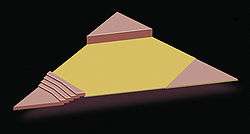Homomonument


The Homomonument is a memorial in the centre of Amsterdam, the capital of the Netherlands. It commemorates all gay men and lesbians who have been subjected to persecution because of their homosexuality. Opened on September 5, 1987, it takes the form of three large pink triangles made of granite, set into the ground so as to form a larger triangle, on the bank of the Keizersgracht canal, near the historic Westerkerk church. The Homomonument was designed to "inspire and support lesbians and gays in their struggle against denial, oppression and discrimination." It was the first monument in the world to commemorate gays and lesbians who were killed by the Nazis.[1]
Later, similar monuments were realised in a number of cities all around the world.
History
In 1980 artists were invited to submit designs and a jury was assembled consisting of experts in the fields of art and design. The jury chose a design by Karin Daan, based on the pink triangle.[1] With the triangle on the water as its central point, Daan expanded the design to make her work as monumental as possible without disrupting the surroundings.
The idea of a permanent memorial to gay and lesbian victims of persecution dated from 1970, when gay activists were arrested for attempting to place a lavender wreath at the National War Memorial (Netherlands) on Dam Square in the centre of Amsterdam. The wreath was removed by police and denounced as a disgrace.
In 1979 the Dutch gay and lesbian rights movement started an initiative to raise funds for a monument, with the support of groups in other countries. It took eight years to raise the necessary €180,000 to build the Homomonument. Most of this came from donations from individuals and organisations. The Dutch Parliament donated €50,000, and the city of Amsterdam and the province of North Holland also made contributions.
A monument in memory of LGBT victims of repression and persecution was dedicated in Barcelona, Spain in 2011.[2] It was modeled after the Homomonument.[3]
Design
As well as the triangle on the canal, which has a set of steps leading to the water where floral wreaths are frequently laid, there is a triangle on land 60 cm high and a memorial triangle at street level. The three triangles—each measuring 10 meters (30 ft) on each side—together form a larger triangle connected on each side by a thin row of pink granite bricks. This larger triangle measures 36 meters on each side.
The alignments of the three points of the larger triangle are symbolic. One points towards the National War Memorial on Dam Square. One points towards the house of Anne Frank, a Jewish girl who was deported to her death by the Nazis. The third points towards the headquarters of COC Nederland, the Dutch gay rights group founded in 1946, making it the oldest continuously operating gay and lesbian organisation in the world.
On the triangle pointing towards the Anne Frank House is engraved a line of poetry by the Dutch Jewish gay poet Jacob Israël de Haan (1881–1924): Naar Vriendschap Zulk een Mateloos Verlangen ("Such an endless desire for friendship"). The text is from his poem To a Young Fisherman.[1]
A miniature version of the Homomonument can be seen at The Hague's Madurodam park. The scale model was unveiled on October 24, 2006, by Amsterdam mayor Job Cohen and COC chair Frank van Dalen.[4]
Coordinates: 52°22′28″N 4°53′05″E / 52.3744°N 4.8848°E
References
- 1 2 3 Martin Dunford (2010). The Rough Guide to The Netherlands. Penguin. p. 73. ISBN 978-1-84836-882-8.
- ↑ "Barcelona unveiled the first monument to repressed gay and lesbian people". Catalannewsagency.com. Retrieved 2013-02-12.
- ↑ "Barcelona Gay And Lesbian Monument Plans Outlined". Huffingtonpost.com. 2011-01-03. Retrieved 2013-02-12.
- ↑ Article from COC Nederland (Dutch)
External links
| Wikimedia Commons has media related to Homomonument in Amsterdam. |